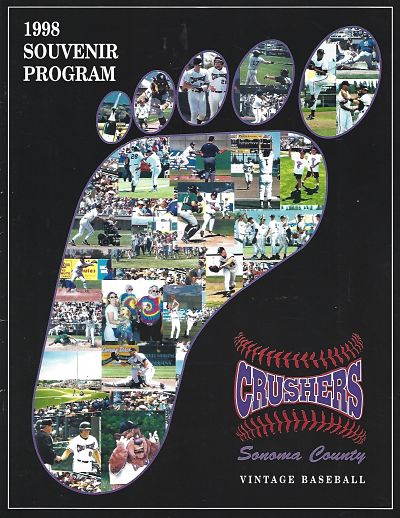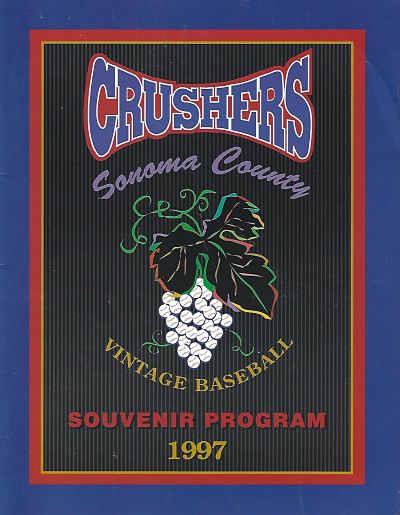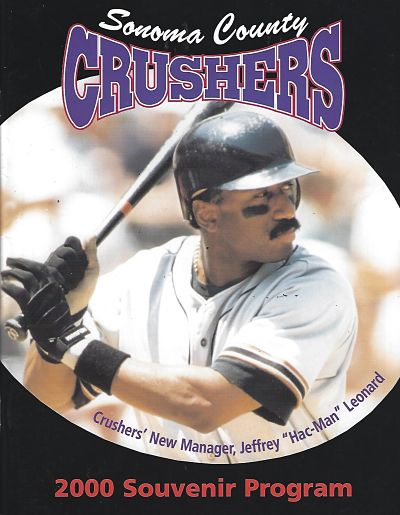Western Baseball League (1995-2002)
Tombstone
Born: 1994 – WBL founding franchise
Folded: October 2002
First Game: May 19, 1995 (W 8-7 vs. Salinas Peppers)
Last Game: September 5, 2002 (L 1-0 @ Chico Heat)
Western League Champions: 1998
Stadium
Rohnert Park Stadium (4,138)11996 Western Baseball League Media Guide
Opened: 1981
Dimensions (1998): 320′ – 391′ – 320′
Marketing
Team Colors: Purple, Cardinal & Black21996 Western Baseball League Media Guide
Ownership & Affiliation
Owners: Bob Fletcher & Susan Fletcher
Major League Affiliation: Independent
Attendance
Tap (mobile) or mouse over chart for figures. Tilting your mobile device may offer better viewing.
Sources:
- 1995-2000 & 2002 Figures3The Encyclopedia of Minor League Baseball (3rd ed.), Lloyd Johnson & Miles Wolff, 2007
- 2001 Figures4Baseball America 2002 Almanac*
*2001 Western Baseball League attendance figures in The Encyclopedia of Minor League Baseball (3rd Edition) are incorrect. They are the 2002 figures printed in the wrong year.
Background
The Sonoma County Crushers were an independent pro baseball outfit that enjoyed a relatively long run of eight years by indy ball standards. In fact, the Crushers were the only franchise in the Western Baseball League (1995-2002) that hung in there for all eight seasons of the league’s existence.
The Crushers played in Rohnert Park, California, a planned community of 40,000 located about 50 miles north of San Francisco. The city previously hosted the Redwood Pioneers of the Class A California League from 1980 until 1985 but had not enjoyed professional baseball in a decade before the Crushers arrived.
A sequence of retired San Francisco Giants stars managed the team over the years, including Dick Dietz (1996-1999), Jeff Leonard (2000) and Kevin Mitchell (2002).
Mitchell, the National League’s Most Valuable Player with the Giants in 1989, also played for the Crushers during the 2000 season, hitting .286 with 7 homers in 45 games.
Championship Season
The Crushers won the 1998 Western Baseball League championship with a 3-game sweep of the Western Warriors that September.
The series against the Warriors reflected the Western League’s chronic instability. The Warriors began the 1998 season as the Grays Harbor Gulls from Washington state. After the Gulls owners ran out of money in June, league officials changed the team’s name to the Western Warriors and sent the now-homeless club on a 68-game road trip. The Warriors improbably found their way into the championship series before the Crushers slammed the book shut on their Cinderella story.
Top Players
The Crushers’ greatest success story was pitcher Chad Zerbe, who made 14 appearances for the club in 1997. Zerbe, then 25, had been cut loose by the Los Angeles Dodgers after six seasons in their farm system. After one season in indy ball with the Crushers, Zerbe latched on with the San Francisco Giants organization. He finally made it to the Majors at age 28 in September 2000. Zerbe went on to pitch four season for the Giants and was credited with a victory in Game 5 of the 2002 World Series against the Anaheim Angels.
A more typical Western League story was that of fan favorite slugger Todd Pridy. A strapping first baseman from nearby Napa, Pridy was a 23rd round draft pick of the Florida Marlins in 1992. After two promising seasons of Class A ball with the Marlins, injuries and circumstance landed Pridy in the Western League in 1995 with the Salinas Peppers. After winning the league MVP award in 1996 at Salinas, Pridy signed with the Crushers in 1997. Living at home with his family, Pridy tore up the league from 1997 to 1999. During the Crushers 1998 championship season in 1998, Pride hit .408 with 21 homers and won his second Western League MVP award. But he never returned to organized baseball.
Pridy returned from a two-year retirement to play with the Crushers during their final season in 2002.
The End
The Crushers were owned for all eight of their seasons by Bob Fletcher, a retired IBM executive, and his wife Susan. Fletcher invested nearly $500,000 of his own money over the years improving Rohnert Park Stadium. In return the Crushers paid just a $1 annual fee for their lease of the city-owned ballpark.5Mohan, Geoffrey. “Even Baseball Is Out at Home in Rohnert Park”. The Times (Los Angeles, CA). June 9, 2003
In October 2002, Fletcher withdrew the Crushers from the Western League, citing a lack of confidence in the other owners. The Fletchers hoped to attract interest from another minor league baseball organization and continued to take season ticket deposits for a while. It’s not clear they could have found another league. Regardless, the city of Rohnert Park terminated the Fletchers’ lease deal in early 2003 as part of a broader effort to sell off city-owned properties to commercial developers amidst a budget crisis.
Rohnert Park Stadium was demolished in 2005 and is reportedly the site of a Costco today.
In Memoriam
Manager Dick Dietz (Crushers ’96-’99) died of a heart attack on June 28, 2005. A former National League All-Star catcher with the San Francisco Giants (1970), Dietz was 63 years old. New York Times obituary.
Downloads
1997 Sonoma County Crushers Roster
1997 Sonoma County Crushers Roster
Links
##




One Response
hi there,
just wanted to note, since I had enjoyed the pioneers games as a kid, and spent many a game there with my family and have lived in rohnert park since 1981 : the former crushers stadium / redwood pioneers stadium is not the site of costco, but rather, the former location is now occupied by an apartment complex, as well as the cambria hotel, on labath avenue, just north of the chp station.
if one were to look at the google map right now, the old stadum property used to stretch from just just to the north of the chp property (the other side of hinebaugh creek) to just south of the SELPA school there. prior to costco being built in it’s current location, it was a big empty field, and costco itself used to reside in the same location where our movie theater currently resides prior to moving to it’s redwood drive location.
at one point both costco and the ball field were adjacent to eachother prior to the field’s demolition, rather than replacing the field